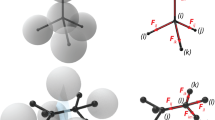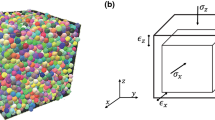Abstract
Various factors, such as the volumetric fraction of constituents, mineralogy, and pore fluids, affect heat flow in granular materials. Although the stress applied on granular materials controls the formation of major pathways for heat flow, few studies have focused on a detailed investigation of its significance with regard to the thermal conductivity and anisotropy of the materials. This paper presents a numerical investigation of the stress-induced evolution of anisotropic thermal conductivity of dry granular materials with supplementary experimental results. Granular materials under a variety of stress conditions in element testing are analyzed by the three-dimensional discrete element method, and quantitative variations in their anisotropic effective thermal conductivity are calculated via the network model and conductivity tensor measurements. Results show that the directional development of contact area and fabric under anisotropic stress conditions leads to the evolution of anisotropy in thermal conductivity. The anisotropy induced in thermal conductivity by shear stress is higher than that induced by compressive stress because shear stress causes more significant changes in microstructural configurations and boundary conditions. The shear-stress-induced evolution of anisotropy between principal thermal conductivities depends on dilatancy as well as shearing mode, and the shear-driven discontinuity localizes the conductivity. Factors involved in the stress-induced evolution and their implications on the thermal conductivity characterization are discussed.















Similar content being viewed by others
References
Abdulagatova Z, Abdulagatov IM, Emirov VN (2009) Effect of temperature and pressure on the thermal conductivity of sandstone. Int J Rock Mech Min Sci 46(6):1055–1071. doi:10.1016/j.ijrmms.2009.04.011
Andersland OB, Ladanyi B (2004) Frozen ground engineering, 2nd edn. Wiley, New York
Batchelor GK, O’Brien RW (1977) Thermal or electrical conduction through a granular material. Proc R Soc Lond A 355(1682):313–333
Becker BR, Misra A, Fricke BA (1992) Development of correlations for soil thermal conductivity. Int Commun Heat Mass Transf 19(1):59–68. doi:10.1016/0735-1933(92)90064-o
Chen S (2008) Thermal conductivity of sands. Heat Mass Transf 44(10):1241–1246. doi:10.1007/s00231-007-0357-1
Cortes DD, Martin AI, Yun TS, Francisca FM, Santamarina JC, Ruppel C (2009) Thermal conductivity of hydrate-bearing sediments. J Geophys Res 114:B11103. doi:10.1029/2008jb006235
Côté J, Konrad J-M (2005) A generalized thermal conductivity model for soils and construction materials. Can Geotech J 42(2):443–458. doi:10.1139/t04-106
Davis MG, Chapman DS, Van Wagoner TM, Armstrong PA (2007) Thermal conductivity anisotropy of metasedimentary and igneous rocks. J Geophys Res 112(B5):B05216. doi:10.1029/2006jb004755
Demirci A, Görgülü K, Durutürk YS (2004) Thermal conductivity of rocks and its variation with uniaxial and triaxial stress. Int J Rock Mech Min Sci 41(7):1133–1138. doi:10.1016/j.ijrmms.2004.04.010
El Shamy U, De Leon O, Wells R (2011) DEM study on effect of shear-induced anisotropy on thermal conductivity of granular soils. Int J Geomech. doi:10.1061/(ASCE)GM.1943-5622.0000165
Esch DC (2004) Thermal analysis, construction and monitoring methods for frozen ground, vol 492. American Society of Civil Engineers, Resteon
Espinoza D, Kim S, Santamarina J (2011) CO2 geological storage—geotechnical implications. KSCE J Civil Eng 15(4):707–719. doi:10.1007/s12205-011-0011-9
Garrett D, Ban H (2011) Compressive pressure dependent anisotropic effective thermal conductivity of granular beds. Granul Matter 13(5):685–696. doi:10.1007/s10035-011-0273-4
Gori F, Corasaniti S (2004) Theoretical prediction of the thermal conductivity and temperature variation inside mars soil analogues. Planet Space Sci 52(1–3):91–99. doi:10.1016/j.pss.2003.08.009
Gustafsson SE et al (1979) Transient hot-strip method for simultaneously measuring thermal conductivity and thermal diffusivity of solids and fluids. J Phys D Appl Phys 12(9):1411
Holtzman R, Silin DB, Patzek TW (2010) Frictional granular mechanics: a variational approach. Int J Numer Meth Eng 81(10):1259–1280. doi:10.1002/nme.2727
Itasca (2003) PFC(3D) (Particle Flow Code in three dimensions) Version 3.0, Minneapolis
Jang E-R, Jung Y-H, Chung C-K (2010) Stress ratio-fabric relationships of granular soils under axi-symmetric stress and plane-strain loading. Comput Geotech 37(7–8):913–929. doi:10.1016/j.compgeo.2010.07.010
Johansen O (1975) Thermal conductivity of soils. University of Trondheim, Trondheim
Johnston I, Narsilio G, Colls S (2011) Emerging geothermal energy technologies. KSCE J Civil Eng 15(4):643–653. doi:10.1007/s12205-011-0005-7
Kanuparthi S, Subbarayan G, Siegmund T, Sammakia B (2008) An efficient network model for determining the effective thermal conductivity of particulate thermal interface materials. IEEE Trans Compon Packag Technol 31(3):611–621
Kim J-S, Kwon S-K, Sanchez M, Cho G-C (2011) Geological storage of high level nuclear waste. KSCE J Civil Eng 15(4):721–737. doi:10.1007/s12205-011-0012-8
Kim DH, Kim YJ, Lee J-S, Yun TS (2011) Thermal and electrical response of unsaturated hydrophilic and hydrophobic granular materials. Geotech Test J 34(5):562–570. doi:10.1520/GTJ103601
Krzewinski TG, Tart JRG (1985) Thermal design considerations in frozen ground engineering. State of the Practice Report. Tech Council Cold Reg Eng ASCE
Midttomme K, Roaldset E, Aagaard P (1998) Thermal conductivity of selected claystones and mudstones from England. Clay Miner 33(1):131–145
Nan C-W, Birringer R, Clarke DR, Gleiter H (1997) Effective thermal conductivity of particulate composites with interfacial thermal resistance. J Appl Phys 81(10):6692–6699
Ng TT (2005) Behavior of gravity deposited granular material under different stress paths. Can Geotech J 42(6):1644–1655. doi:10.1139/t05-080
Ng TT (2006) Input parameters of discrete element methods. J Eng Mech 132(7):723–729. doi:10.1061/(asce)0733-9399(2006)132:7(723
O’Sullivan C, Bray JD (2004) Selecting a suitable time step for discrete element simulations that use the central difference time integration scheme. Eng Comput 21(2–4):278–303
Reinecke BN, Shan JW, Suabedissen KK, Cherkasova AS (2008) On the anisotropic thermal conductivity of magnetorheological suspensions. J Appl Phys 104(2):023507. doi:10.1063/1.2949266
Rognon P, Einav I, Bonivin J, Miller T (2010) A scaling law for heat conductivity in sheared granular materials. EPL (Europhys Lett) 89(5):58006
Rothenburg L, Bathurst RJ (1989) Analytical study of induced anisotropy in idealized granular materials. Géotechnique 39(4):601–614
Santamarina JC (2001) Soils and waves. Wiley, New York
Singh DN, Devid K (2000) Generalized relationships for estimating soil thermal resistivity. Exp Therm Fluid Sci 22(3–4):133–143. doi:10.1016/s0894-1777(00)00020-0
Tarnawski VR, Leong WH, Gori F, Buchan GD, Sundberg J (2002) Inter-particle contact heat transfer in soil systems at moderate temperatures. Int J Energy Res 26(15):1345–1358. doi:10.1002/er.853
Tarnawski VR, Momose T, Leong WH (2009) Estimation of quartz content in soils from thermal conductivity data. Géotechnique 59(4):331–338
Tarnawski V, Momose T, Leong WH, Bovesecchi G, Coppa P (2009) Thermal conductivity of standard sands. Part I. Dry-state conditions. Int J Thermophys 30(3):949–968. doi:10.1007/s10765-009-0596-0
Tehranian F, Abdou MA, Tillack MS (1994) Effect of external pressure on particle bed effective thermal conductivity. J Nucl Mater 212–215(Part 2):885–890. doi:10.1016/0022-3115(94)90963-6
Thornton C (2000) Numerical simulations of deviatoric shear deformation of granular media. Géotechnique 50(1):43–53
Thornton C, Barnes DJ (1986) Computer simulated deformation of compact granular assemblies. Acta Mech 64:45–61
Vargas WL, McCarthy JJ (2002) Stress effects on the conductivity of particulate beds. Chem Eng Sci 57(15):3119–3131. doi:10.1016/s0009-2509(02)00176-8
Weidenfeld G, Weiss Y, Kalman H (2004) A theoretical model for effective thermal conductivity (ETC) of particulate beds under compression. Granul Matter 6(2):121–129. doi:10.1007/s10035-004-0170-1
Yan WM (2009) Fabric evolution in a numerical direct shear test. Comput Geotech 36(4):597–603. doi:10.1016/j.compgeo.2008.09.007
Yimsiri S, Soga K (2000) Micromechanics-based stress-strain behaviour of soils at small strains. Géotechnique 50(5):559–571
Yimsiri S, Soga K (2011) Effects of soil fabric on behaviors of granular soils: microscopic modeling. Comput Geotech 38(7):861–874. doi:10.1016/j.compgeo.2011.06.006
Yun TS, Evans TM (2010) Three-dimensional random network model for thermal conductivity in particulate materials. Comput Geotech 37(7–8):991–998. doi:10.1016/j.compgeo.2010.08.007
Yun TS, Evans TM (2011) Evolution of at-rest lateral stress for cemented sands: experimental and numerical investigation. Granul Matter 13(5):671–683
Yun TS, Santamarina JC (2008) Fundamental study of thermal conduction in dry soils. Granul Matter 10(3):197–207. doi:10.1007/s10035-007-0051-5
Yun TS, Dumas B, Santamarina JC (2011) Heat transport in granular materials during cyclic fluid flow. Granul Matter 13(1):29–37. doi:10.1007/s10035-010-0220-9
Zhao X, Evans TM (2009) Discrete simulations of laboratory loading conditions. Int J Geomech 9(4):169–178
Acknowledgments
The authors are grateful to Dr. Eui-Ryong Jang at Seoul National University for his valuable comments on the DEM simulations. The expert opinion from the anonymous reviewers is greatly appreciated. Financial support for this work was provided by a grant from a Strategic Research Project Development of Extreme Cold Region Site Investigation and Monitoring System funded by the Korea Institute of Construction Technology (KICT), the basic science research program through National Research Foundation of Korea (NRF) funded by the Ministry of Education, Science and Technology (No. 2011-0005593), and the Korea Institute of Geosciences and Mineral Resources (KIGAM).
Author information
Authors and Affiliations
Corresponding author
Appendices
Appendix A: Estimation of thermal conductivity via the thermal network model
Suppose that the granular assembly comprises a web of particles interconnected by thermal conductors. When the sum of heat flow (q ij ) of all the connected thermal conductors from particles i and j is in equilibrium with a temperature difference (T i − T j ) and thermal conductance (C ij ) between the particles, energy conservation leads to the following steady-state equation:
The initial temperature at each particle is determined by imposing constant temperature at the two boundary planes (e.g., top and bottom planes for \( k_{zz}^{\text{eff}} \)) and then performing successive iterations until the variation of temperature in each step becomes lower than a prescribed value. The thermal energy between particles is determined by the particle conductance (\( C_{i}^{\text{p}} \)) and contact conductance (\( C_{ij}^{\text{c}} \)), given by the following equation:
The neighboring particles can be considered to be either connected by a circular contact (i.e., overlapped) or separated (i.e., not overlapped), depending on the distance between particles (h ij ), which is given by the following relation:
where D is the distance between the particle centers, and r i and r j are the radii of particles i and j, respectively. The particles are interconnected when h ij ≤ 0, and separated otherwise. It is assumed that heat transfer occurs between particles when h ij is lower than εeff:
where ε is the cut-off range parameter to define the effective zone of heat transfer. Following the calculation of the temperature of particles in a random assembly by iterating Eq. (a1) according to conductance as described in [3, 46], the total heat flow of all the particles is determined by Eq. (a2). Finally, the effective thermal conductivity of a given granular assembly k eff is given by using Fourier’s law.
where Q is the total heat flow out of the boundary plane; H and A are the height and cross-sectional area of the assembly, respectively; and ΔT is the temperature difference between the two boundary planes.
Appendix B: Numerical formulation of the thermal conductivity tensor measurements
Assume a particle and a contact represent a heat reservoir and a one-dimensional thermal pipe, respectively. If we regard that heat flow occurs only in the thermal pipes, the average heat flux in a volume V of granular material is defined by a sum over all M pipes (see [17] for detailed derivation):
where A (p) and l (p) are the length and cross-sectional area of pipe p, respectively, and the heat flux in the pipe \( q_{i}^{(p)} \) is given by the following relation:
where ΔT is the temperature difference between the two reservoirs on each end of the pipe; η i is the outward unit normal vector; and L and η are the length and the thermal resistance per unit length of the pipe, respectively.
If the mean temperature gradient in the material, \( \partial T/\partial x_{j} \), is applied at the microlevel within each pipe, then the temperature difference is given as shown below.
Substituting Eqs. (b2) and (b3) into (b1) gives the following equation:
The heat flux vector and the temperature gradient are related by Fourier’s law for a continuum, as shown below:
By comparing Eq. (b4) with Fourier’s law, Eq. (b5), the thermal conductivity tensor of the granular material is given by the following equation:
Rights and permissions
About this article
Cite this article
Choo, J., Kim, Y.J., Lee, J.H. et al. Stress-induced evolution of anisotropic thermal conductivity of dry granular materials. Acta Geotech. 8, 91–106 (2013). https://doi.org/10.1007/s11440-012-0174-7
Received:
Accepted:
Published:
Issue Date:
DOI: https://doi.org/10.1007/s11440-012-0174-7




